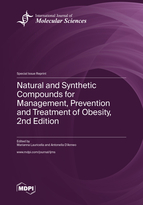Natural and Synthetic Compounds for Management, Prevention and Treatment of Obesity, 2nd Edition
A special issue of International Journal of Molecular Sciences (ISSN 1422-0067). This special issue belongs to the section "Molecular Pharmacology".
Deadline for manuscript submissions: closed (28 February 2023) | Viewed by 28066
Special Issue Editors
Interests: mechanisms of oxidative stress induction and main antioxidant systems; biochemical pathways of cell death and survival (apoptosis, necrosis, autophagy) in tumor cells; effects of phytocompounds in obesity reduction
Special Issues, Collections and Topics in MDPI journals
Interests: biochemical pathways in cancer cell death (apoptosis, necrosis, necroptosis, autophagy and anoikis); nutrition and human diseases; oxidative stress; signal transduction; targeted therapies; cancer stem-like cells; analysis of the behaviours of phytocompounds in obesity treatment
Special Issues, Collections and Topics in MDPI journals
Special Issue Information
Dear Colleagues,
Obesity is a serious worldwide health concern with a high incidence of mortality and morbidity. Many drivers have been identified for its etiopathogenesis, such as an imbalance between energy intake and its expenditure, resulting from a combination of excessive food intake, a sedentary lifestyle, reduced physical activity and genetic predisposition. In addition, environmental chemicals, such as pesticides, organotins and phthalates, have also been shown to occupy a decisive role in promoting obesity. These obesogens represent risk factors during fetal development, predisposing offspring to weight gain later in life. Adipose tissue plays an active metabolic role in regulating energy storage and its utilization. In addition, it may be considered an endocrine organ since it produces and secretes multiple immune-modulatory proteins, known as adipokines. Through adipokines, adipose tissue regulates several important physiological functions, including insulin sensitivity and secretion, glucose and lipid metabolism, blood pressure and the function of the immune system. Adipokines can be classified as molecules with a pro-inflammatory or anti-inflammatory nature. An unbalanced production of adipokines with a pro-inflammatory role in adipose tissue induces low-grade systemic inflammation in obese patients, which predisposes them to insulin resistance, type II diabetes, non-alcoholic fatty liver disease, cardiovascular disorders and cancer. Therefore, the reduction in adipose tissue in obese subjects represents an important goal for the prevention and treatment of these chronic diseases. Nowadays, there has been a growing interest in finding novel target compounds, both natural and synthetic, with potential action against obesity. Investigating the effects of these compounds in reducing obesity and preventing its associated diseases could provide novel insights and further advance the knowledge base of this field. We are inviting investigators to contribute either original research or review articles to this upcoming Special Issue. Papers focusing on the pathophysiology of obesity as well as on the identification of compounds capable of managing an obesity profile and disease-related conditions are welcome.
Dr. Marianna Lauricella
Dr. Antonella D'Anneo
Guest Editors
Manuscript Submission Information
Manuscripts should be submitted online at www.mdpi.com by registering and logging in to this website. Once you are registered, click here to go to the submission form. Manuscripts can be submitted until the deadline. All submissions that pass pre-check are peer-reviewed. Accepted papers will be published continuously in the journal (as soon as accepted) and will be listed together on the special issue website. Research articles, review articles as well as short communications are invited. For planned papers, a title and short abstract (about 100 words) can be sent to the Editorial Office for announcement on this website.
Submitted manuscripts should not have been published previously, nor be under consideration for publication elsewhere (except conference proceedings papers). All manuscripts are thoroughly refereed through a single-blind peer-review process. A guide for authors and other relevant information for submission of manuscripts is available on the Instructions for Authors page. International Journal of Molecular Sciences is an international peer-reviewed open access semimonthly journal published by MDPI.
Please visit the Instructions for Authors page before submitting a manuscript. There is an Article Processing Charge (APC) for publication in this open access journal. For details about the APC please see here. Submitted papers should be well formatted and use good English. Authors may use MDPI's English editing service prior to publication or during author revisions.
Keywords
- obesity
- adipokines
- obesogens
- genetic predisposition
- natural/synthetic compounds
- cardiovascular disorders
- type II diabetes
- non-alcoholic fatty liver disease
- cancer








